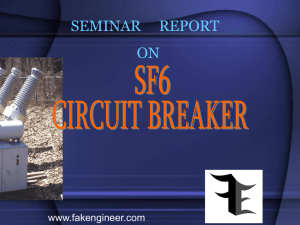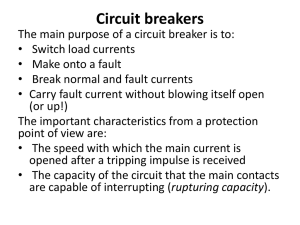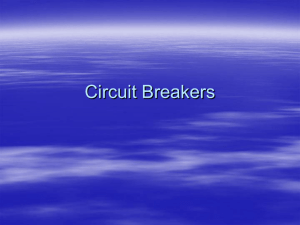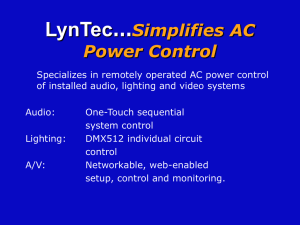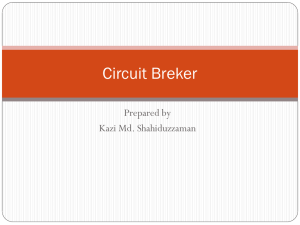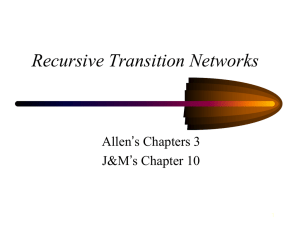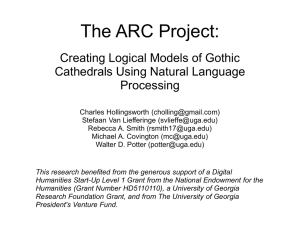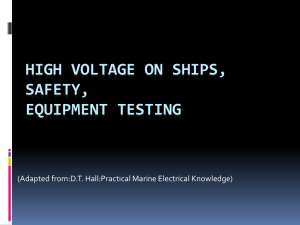Detail Discussion on Different type of Circuit Breaker
advertisement
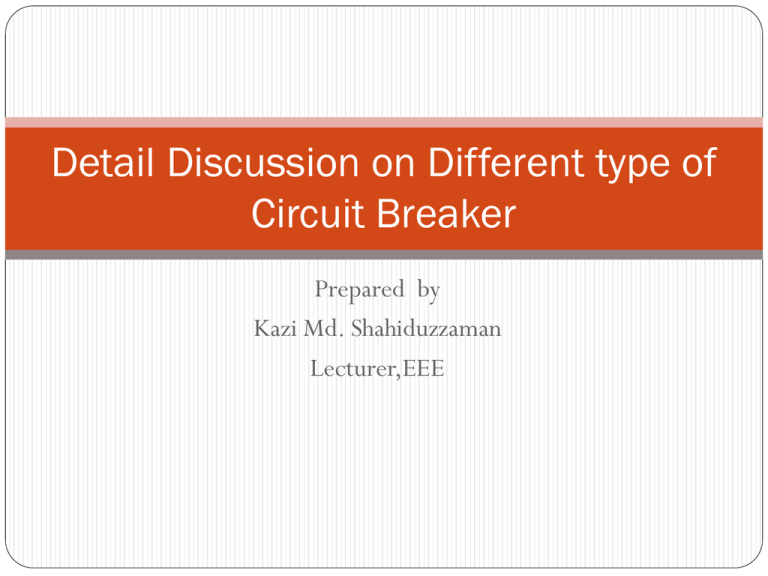
Detail Discussion on Different type of Circuit Breaker Prepared by Kazi Md. Shahiduzzaman Lecturer,EEE Outline of this chapter Construction of Different type of C.B. Working principle of Different type of C.B. Advantages and Disavdantages of Different type of C.B. Low oil Circuit Breaker Construction: Fig shows the cross section of a single phase low oil circuit breaker. Separated from each other but both filled with oil. The upper chamber is the circuit breaking chamber. The lower one is the supporting chamber. The two chambers are separated by a partition and oil from one chamber is prevented from mixing with the other chamber. This arrangement permits two advantages. Firstly, the circuit breaking chamber requires a small volume of oil which is just enough for arc extinction. Secondly, the amount of oil to be replaced is reduced as the oil in the supporting chamber does not get contaminated by the arc. Low oil Circuit Breaker Operation: Under normal operating conditions, the moving contact remains engaged with the upper fixed contact. When a fault occurs, the moving contact is pulled down and an arc is struck. The arc energy vaporises the oil and produces gases under high pressure. This action constrains the oil to pass through a central hole in the moving contact and results in forcing series of oil through the respective passages of the turbulator. The process of turbulation is orderly one, in which the sections of the arc are successively quenched by the effect of separate streams of oil moving across each section in turn and bearing away its gases. Low oil Circuit Breaker Advantages: A low oil circuit breaker has the following advantages over a bulk oil circuit breaker: (i) It requires lesser quantity of oil. (ii) It requires smaller space. (iii) There is reduced risk of fire. (iv) Maintenance problems are reduced. Disadvantages: A low oil circuit breaker has the following disadvantages as compared to a bulk oil circuit breaker : (i) Due to smaller quantity of oil, the degree of carbonisation is increased. (ii) There is a difficulty of removing the gases from the contact space in time. (iii) The dielectric strength of the oil deteriorates rapidly due to high degree of carbonisation Sulphur Hexaflouride (SF6) Circuit Breakers Construction: • Fig. shows the parts of a typical SF6 circuit breaker. • It consists of fixed and moving contacts enclosed in a chamber containing SF6 gas. •When the contacts of breaker are opened, the valve mechanism permits a high pressure SF6 gas from the reservoir to flow towards the arc interruption chamber. • The fixed contact is a hollow cylindrical current carrying contact fitted with an arc horn. • The moving contact is also a hollow cylinder with rectangular holes in the sides to permit the SF6 gas to let out through these holes after flowing along and across the arc. • The tips of fixed contact, moving contact and arcing horn are coated with copper-tungsten arc resistant material. • Since SF6 gas is costly, it is reconditioned and reclaimed by suitable auxiliary sytem after each operation of the breaker. Sulphur Hexaflouride (SF6) Circuit Breakers Working Principle: • In the closed position of the breaker, the contacts remain surrounded by SF6 gas at a pressure of about 2·8 kg/ cm2. •When the breaker operates, the moving contact is pulled apart and an arc is struck between the contacts. The movement of the moving contact is synchronised with the opening of a valve which permits SF6 gas at 14 kg/ cm2 pressure from the reservoir to the arc interruption chamber. The high pressure flow of SF6 rapidly absorbs the free electrons in the arc path to form immobile negative ions which are ineffective as charge carriers. •The result is that the medium between the contacts quickly builds up high dielectric strength and causes the extinction of the arc. • After the breaker operation (i.e., after arc extinction), the valve is closed by the action of a set of springs. Sulphur Hexaflouride (SF6) Circuit Breakers Advantages: (i) Due to the superior arc quenching property of SF6, such circuit breakers have very short arcing time. (ii) Since the dielectric strength of SF6 gas is 2 to 3 times that of air, such breakers can interrupt much larger currents. (iii) The SF6 circuit breaker gives noiselss operation due to its closed gas circuit and no exhaust to atmosphere unlike the air blast circuit breaker (iv) The closed gas enclosure keeps the interior dry so that there is no moisture problem. (v)There is no risk of fire in such breakers because SF6 gas is non-inflammable. (vi) There are no carbon deposits so that tracking and insulation problems are eliminated. (vii) The SF6 breakers have low maintenance cost, light foundation requirements and minimum auxiliary equipment. (viii) Since SF6 breakers are totally enclosed and sealed from atmosphere, they are particularly suitable where explosion hazard exists e.g., coal mines. Disadvantages: (i) SF6 breakers are costly due to the high cost of SF6. (ii) Since SF6 gas has to be reconditioned after every operation of the breaker, additional equipment is requried for this purpose. Vacuum Circuit Breakers (VCB) Construction: Fig. shows the parts of a typical vacuum circuit breaker. It consists of fixed contact, moving contact and arc shield mounted inside a vacuum chamber. A glass vessel or ceramic vessel is used as the outer insulating body. The arc shield prevents the deterioration of the internal dielectric strength by preventing metallic vapours falling on the inside surface of the outer insulating cover. Vacuum Circuit Breakers (VCB) Working: When the breaker operates, the moving contact separates from the fixed contact and an arc is struck between the contacts. The production of arc is due to the ionisation of metal ions and depends very much upon the material of contacts. The arc is quickly extinguished because the metallic vapours, electrons and ions produced during arc are diffused in a short time. Vacuum Circuit Breakers (VCB) Advantages: (i) They are compact, reliable and have longer life. (ii) There are no fire hazards. (iii) There is no generation of gas during and after operation. (iv) They can interrupt any fault current.The outstanding feature of aVCB is that it can break any heavy fault current perfectly just before the contacts reach the definite open position. (v) They require little maintenance and are quiet in operation. (vi) They can successfully withstand lightning surges. (vii) They have low arc energy. (viii) They have low inertia and hence require smaller power for control mechanism. Thank you Self Study: Advantages and Disadvantages of Bulk oil CB and Air Blast CB
